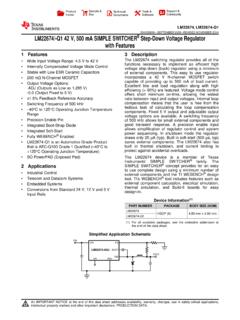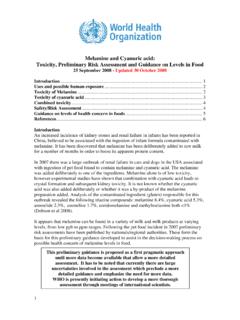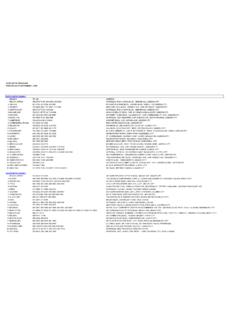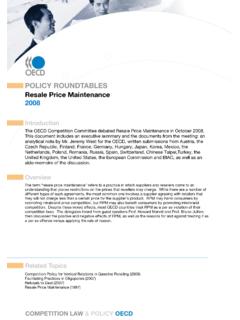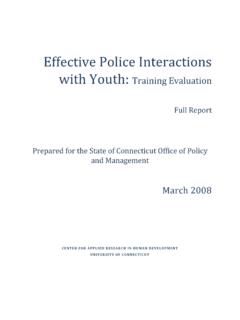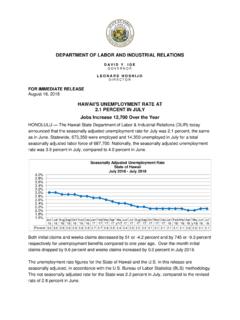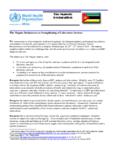Transcription of Overhauling the Engine of Growth: Infrastructure in Africa
1 EXECUTIVE SUMMARY. Africa Infrastructure . COUNTRY DIAGNOSTIC. Overhauling the Engine of growth : Infrastructure in Africa Vivien Foster september 2008 . DRAFT. This report was produced by the World Bank with funding and other support from (in alphabetical order): the African Development Bank, the African Union, the Agence Fran aise de D veloppement, the European Union, the New Economic Partnership for Africa 's Development, the Public-Private Infrastructure Advisory Facility, and the Department for International Development. About AICD. This study is part of the Africa Infrastructure Country Diagnostic (AICD), a project designed to expand the world's knowledge of physical Infrastructure in Africa . AICD will provide a baseline against which future improvements in Infrastructure services can be measured, making it possible to monitor the results achieved from donor support. It should also provide a more solid empirical foundation for prioritizing investments and designing policy reforms in the Infrastructure sectors in Africa .
2 AICD will produce a series of reports (such as this one) that provide an overview of the status of public expenditure, investment needs, and sector performance in each of the main Infrastructure sectors, including energy, information and communication technologies, irrigation, transport, and water and sanitation. The World Bank will publish a summary of AICD's findings in July 2009. The underlying data will be made available to the public through an interactive Web site allowing users to download customized data reports and perform simple simulation exercises. The first phase of AICD focuses on 24 countries that together account for 85. percent of the gross domestic product, population, and Infrastructure aid flows of Sub-Saharan Africa . The countries are: Benin, Burkina Faso, Cape Verde, Cameroon, Chad, Congo (Democratic Republic of Congo), C te d'Ivoire, Ethiopia, Ghana, Kenya, Madagascar, Malawi, Mali, Mozambique, Namibia, Niger, Nigeria, Rwanda, Senegal, South Africa , Sudan, Tanzania, Uganda, and Zambia.
3 Under a second phase of the project, coverage will be expanded to include additional countries. AICD is being implemented by the World Bank on behalf of a steering committee that represents the African Union, the New Partnership for Africa 's Development (NEPAD), Africa 's regional economic communities, the African Development Bank, and major Infrastructure donors. AICD grew from an idea presented at the inaugural meeting of the Infrastructure Consortium for Africa , held in London in October 2005. Financing for AICD is provided by a multi-donor trust fund to which the main contributors are the Department for International Development (United Kingdom), the Public Private Infrastructure Advisory Facility, Agence Fran aise de D veloppement, and the European Commission. A group of distinguished peer reviewers from policy making and academic circles in Africa and beyond reviews all of the major outputs of the study, with a view to assuring the technical quality of the work.
4 This and other papers analyzing key Infrastructure topics, as well as the underlying data sources described above, will be available for download from Freestanding summaries are available in English and French. Inquiries concerning the availability of datasets should be directed to A. frica's growth performance has improved markedly during the last decade. Ten out of 48. countries experienced sustained economic growth in excess of 5 percent for the past three years or longer. But that performance still falls short of the 7 percent growth needed to achieve substantial poverty reduction and attain the Millennium Development Goals. Infrastructure has played a significant role in Africa 's recent economic turnaround and will need to play an even greater role if the continent's development targets are to be reached. Across Africa , Infrastructure contributed 99 basis points to per capita economic growth over the period 1990 to 2005, compared with only 68 basis points for other structural policies (Calderon, 2008 ).
5 That contribution is almost entirely attributable to advances in the penetration of telecommunication services. The deterioration in the quantity and quality of power Infrastructure over the same period has had a significant retarding effect on economic growth . If these deficiencies could be cured, the effect would be remarkable. Simulations suggest that if all African countries were to catch up with Mauritius in Infrastructure , per capita economic growth in the region could increase by percentage points. Catching up with Korea's level would bring about economic growth per capita up to percent per year. In a number of countries including Cote d'Ivoire, Democratic Republic of Congo (DRC), and Senegal the impact would be even larger. Africa 's extensive Infrastructure deficit In most African countries, particularly the lower-income countries, Infrastructure emerges as a major constraint on doing business and is found to depress firm productivity by around 40 percent (Escribano and others, 2008 ).
6 For most countries, the negative impact of deficient Infrastructure is at least as large as that associated with crime, red tape, corruption, and financial market constraints. For an important subset of countries, power emerges as by far the most limiting factor, being cited by more than half of firms in more than half of countries as a major business obstacle. However, inefficient functioning of ports and associated customs clearance is an equally significant constraint for a second group of countries. Deficiencies in broader transport Infrastructure and Infrastructure for information and communication technologies (ICT) are less prevalent but nonetheless substantial in some cases. On just about every measure of Infrastructure coverage African countries lag behind their peers in other parts of the developing world (Yepes and others, 2008 ). This lag is perceptible for low- and middle- income countries in Sub-Saharan Africa relative to other low- and middle-income countries (table 1).
7 The differences are particularly large in the case of paved roads, telephone mainlines, and power generation capacity. Moreover, for these three key infrastructures , Africa has been expanding stocks much more slowly than other developing regions meaning that unless something changes the gap will widen over time. Overhauling THE Engine OF growth : Infrastructure IN Africa . The comparison with South Asia a region with similar per capita income is particularly striking. In 1970, Sub-Saharan Africa had almost three times as much generating capacity per million people as South Asia. Three decades later, in 2000, South Asia had left Sub-Saharan Africa far behind it now has almost twice the generation capacity per million people. Similarly, in 1970 Sub-Saharan Africa had twice the mainline telephone density of South Asia, but by 2000 the two regions had drawn even. Africa 's largest Infrastructure deficit is to be Table 1 Africa 's Infrastructure deficit found in the power sector.
8 Whether measured in terms Sub-Saharan Other low-income of generation capacity, electricity consumption, or Normalized units Africa LICs countries security of supply. Africa 's power Infrastructure Paved road density 31 134. delivers only a fraction of the service found elsewhere Total road density 137 211. in the developing world (Eberhard and others, 2008 ). Mainline density 10 78. The 48 countries of Sub-Saharan Africa (with a Mobile density 55 76. combined population of 800 million) generate roughly Internet density 2 3. the same amount of power as Spain (with a Generation capacity 37 326. population of 45 million). Power consumption, at 124 Electricity coverage 16 41. kilowatt hours per capita per year and falling, is only Improved water 60 72. a tenth of that found elsewhere in the developing Improved sanitation 34 51. world, barely enough to power one 100-watt light Source: Yepes and others, 2008 .
9 Bulb per person for three hours a day. Africa 's firms Note: Road density is in kilometers per kilometer squared;. report losing 5 percent of their sales as a result of telephone density is in lines per thousand population; generation capacity is in megawatts per million population; electricity, water frequent power outages; this rises to 20 percent for and sanitation coverage are in percentage of population. informal sector firms unable to afford backup LIC = low-income country. generation facilities. With regard to ICT, on the other hand, Africa is staying closer to developments elsewhere in the world. The percentage of Africa 's population living within range of a GSM signal rose dramatically from 5 percent in 1999 to 57 percent in 2006 (Minges and others, 2008 ). Over the same period, more than 100. million Africans became mobile telephone subscribers. Indeed, in some countries, household access to mobile telephone services now exceeds that of piped water.
10 Internet penetration, however, lags considerably behind, with little more than two million subscribers and a further 12 million estimated to be making use of public access facilities. Africa 's road density is sparse when viewed against the vastness of the continent. As a result, only one-third of Africans living in rural areas are within two kilometers of an all season road, compared with two-thirds of the population in other developing regions. However, due to low population densities, addressing the rural isolation problem would entail a doubling or tripling of the current classified network (Gwilliam and others, 2008 ). This is a challenging prospect. Relative to the continent's income (and hence its ability to pay for maintenance), even current levels of road density look rather high. Indeed, in a number of countries, the asset value of the road network exceeds 30 percent of GDP.










